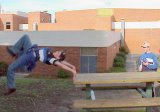
The latest chapter of
Being and Time that I have read deals with being with others and the impact others' being has on us. Some aspects of Heidegger's philosophies feel as though they are starting to crystallise in my mind. I don't expect I will be able to convey these in an easily understandable way for others yet - but what I write is gaining significance for me.
As usual, some quotes:
Is it then obvious that a priori that access to Dasein must be gained by mere reflective awareness of the 'I' of actions? (p. 116)
If the 'I' is an essential characteristic of Dasein, then it is one that must be Interpreted existentially. (p. 152)
Being-with is an existential characteristic of Dasein when factually no Other is present-at-hand or perceived. Even Dasein's Being-alone is Being-with in the world. (p. 156-7)
...those entities towards which Dasein as Being -with comports itself... ...are themselves Dasein. These entities are not objects of concern, but rather solicitude. (p. 157)
Everyday Being-with-one-another maintains itself between the two extremes of positive solicitude - that which leaps in and dominates, and that which leaps forth and liberates. It brings numerous mixed forms to maturity; to describe these and classify them would take us beyond the limits of this investigation. (p. 159)
Being with Others belongs to the Being of Dasein, which is an issue for Dasein in its very being. (p. 160)
Being-with-one-another must follow special routes of its own in order to come close to Others, or even to 'see through them'. (p161)
'Empathy' does not first constitute Being-with; only on the Basis of Being-with does 'empathy' become possible: it gets its motivation from the unsociability of the dominant modes of Being-with. (p. 162)
The "they", which is nothing definite, and which all are, though not as the sum, prescribes the kind of Being of everydayness. (p. 164)
In Dasein's everydayness the agency through which most things come about is one of which we must say that "it was no one". (p. 165)
And because the "they" constantly accommodates the particular Dasein by disburdening it of its Being, the "they" retains and enhances its stubborn dominion. (p. 165)
The Self of everyday Dasein is the they-self, which we distinguish from the
authentic Self - that is, from the Self which has been taken hold of in its own way. As they-self, the particular Dasein has been dispersed into the "they", and must first find itself. (p. 167)
Freedom, Being with, authenticity - which makes me think more about playfulness as a state-of-mind and how that can be shared authentically with others.
I feel that the two extremes of positive solicitude lacks something in explaining the complexities of being-with others, but it is a more than useful illustration and Heidegger himself stops himself short on elaborating.
I will not have this luxury, as being-with others is central to shared playfulness and learning. I think this is an important line of thought for my study.

 I woke up this morning thinking about Heidegger - I have now completed the reading the first section of Being and Time. I will record more detailed thoughts on these two chapters later, but I have to get some stuff out now!
I woke up this morning thinking about Heidegger - I have now completed the reading the first section of Being and Time. I will record more detailed thoughts on these two chapters later, but I have to get some stuff out now!
 The latest chapter of
The latest chapter of 

 The features of playfulness in the pedagogical model of TPL – tutoring, playing and learning
The features of playfulness in the pedagogical model of TPL – tutoring, playing and learning









